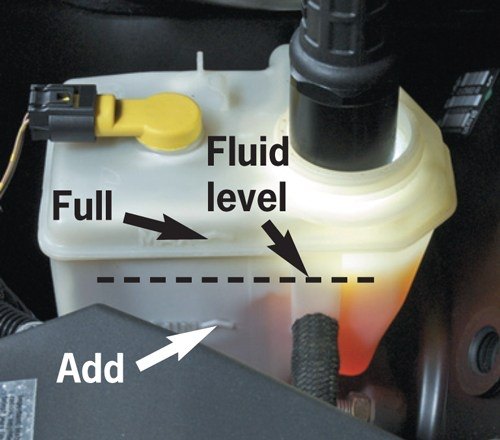In case you’re planning to bleed your brake yourself, here are seven common mistakes that you need to avoid to ensure a good process:
Incorrect Bleeding Order
Bleeding your brakes in the wrong order can have serious consequences.
It can lead to air becoming trapped in your brake system, which can cause your brakes to feel spongy or ineffective.
In severe cases, this can result in complete brake failure, putting you and others at risk.
The correct bleeding order ensures that all air is expelled from the system.
This order typically starts at the farthest wheel from the master cylinder and progresses towards the closest wheel.
However, it’s important to consult your vehicle’s service manual for the exact sequence, as it can vary depending on the make and model.
The reason the order matters is that air tends to rise.
By starting at the farthest wheel, you’re pushing the air toward the master cylinder, where it can be easily expelled.
If you start at the closest wheel, the air may become trapped in the system.
Using Dirty Or Old Tools
When bleeding your brakes, the cleanliness of your tools is paramount.
Contaminated tools can introduce debris into your brake system, leading to a variety of problems.
These contaminants can clog brake calipers, reduce braking performance, and cause noise.
However, to ensure optimal brake function, it’s essential to use clean and well-maintained tools.
A brake wrench, bleeding screw, brake fluid, tubing, a container, and a rag are the essential tools required for a successful brake bleeding process.
After each use, carefully clean your tools to remove any brake fluid or debris.
Not Replacing The Reservoir Cap
The reservoir cap plays an important part in maintaining the proper brake fluid level and preventing air from entering your brake system.
After bleeding your brakes, it’s essential to replace the cap securely to ensure optimal brake performance.
Leaving the cap off can allow air to enter the system, which can lead to spongy brakes or even complete brake failure.
Air in the system can cause the brake pedal to feel soft or spongy, reducing your braking power and control.
To properly replace the cap, simply twist it clockwise until it’s securely fastened.
Make sure there are no leaks around the cap or the reservoir itself.
Not Checking Fluid Level
Regularly checking your brake fluid level is essential for maintaining the safety and performance of your vehicle’s braking system.
Low brake fluid levels can lead to reduced braking power, increased stopping distances, and even complete brake failure.
To check your brake fluid level, locate the brake fluid reservoir, which is typically found under the hood or in the engine compartment.
The reservoir will have a clear plastic window that allows you to see the fluid level.
The fluid level should be between the “full” and “add” marks on the reservoir.

If the level is low, add the correct type of brake fluid, as specified in your owner’s manual.
Avoid overfilling the reservoir, as excess fluid can cause problems.
It’s recommended to check your brake fluid level at least once a month, or more frequently if you notice any changes in your braking performance.
Heavy braking or driving in extreme conditions can cause the fluid level to decrease.
Not Bleeding Completely
Incomplete brake bleeding can also have serious consequences, including reduced braking power, increased stopping distances, and even complete brake failure.
As we’ve said, when air remains trapped in the brake system, it can cause the brake pedal to feel spongy or soft, making it difficult to stop your vehicle effectively.
To ensure complete bleeding, it’s essential to follow the correct bleeding order and repeat the process until all air is expelled from the system.
Refer to your vehicle’s service manual for the specific bleeding sequence.
Signs of incomplete bleeding include a spongy brake pedal, a pulling sensation when braking, or a grinding noise from the brakes.
If you notice any of these symptoms, it’s important to have your brakes inspected by a professional mechanic.
Overfilling The Reservoir
Overfilling the brake fluid reservoir can be just as harmful as having low fluid levels.
Excess brake fluid can create pressure in the system, which can lead to a variety of problems.
One of the main risks of overfilling is that the excess fluid can be forced into the master cylinder.
This can cause the brake pedal to feel spongy or hard, making it difficult to stop your vehicle effectively.
Additionally, overfilled brake fluid can leak out of the reservoir or onto the brake pads, causing contamination and reduced braking performance.
In severe cases, overfilling can even damage the brake system components.
To avoid overfilling the reservoir, only add brake fluid when the level is low.
You can also refer to your owner’s manual for the correct fluid level.
When adding fluid, use a funnel to avoid spills and ensure you don’t add too much.
Not Bleeding The ABS System
If your vehicle has an anti-lock brake system (ABS), bleed it separately from the regular braking system.
Failure to bleed the ABS can lead to reduced braking performance and potential safety risks.
The ABS uses sensors and electronic controls to prevent wheel lockup during braking, which can help you maintain steering control in slippery conditions.
However, if the ABS system is not bled properly, it may not function as intended.
To bleed the ABS system, you may need to use a special diagnostic tool to activate the system and simulate braking conditions.
Lik we’ve said, you can always refer to your vehicle’s service manual for the specific procedure and any necessary tools.
It’s important to have a professional mechanic bleed the ABS system if you’re unsure about the process or if your vehicle has a complex ABS setup.